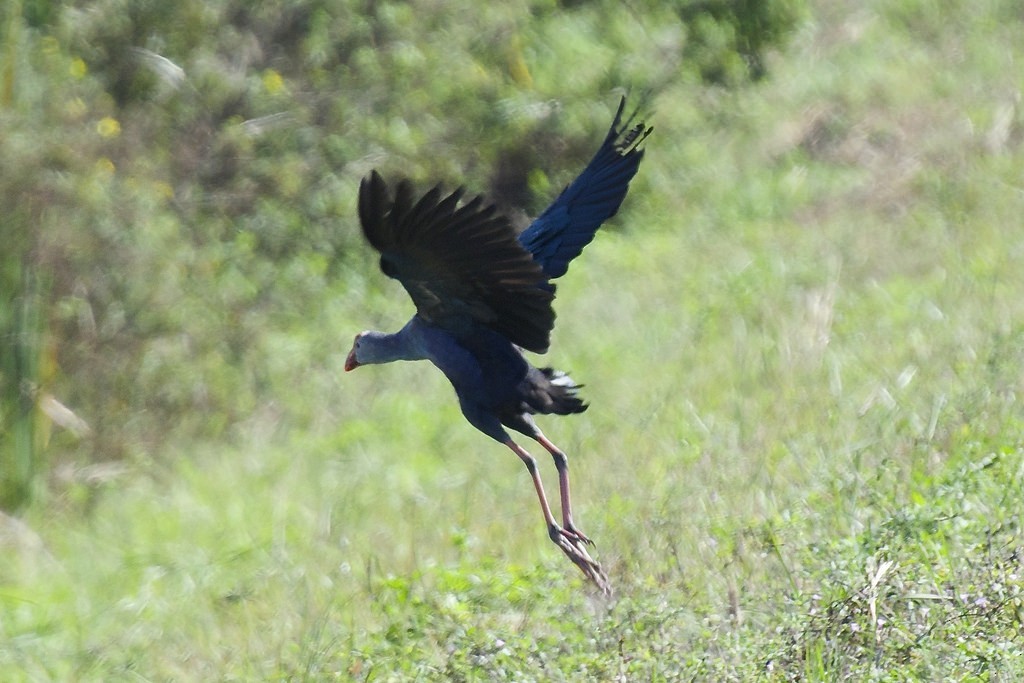Grey-headed Swamphen
A species of Swamphens, Also known as Purple Swamphen Scientific name : Porphyrio poliocephalus Genus : Swamphens
Grey-headed Swamphen, A species of Swamphens
Also known as:
Purple Swamphen
Botanical name: Porphyrio poliocephalus
Genus: Swamphens
Content
Description General Info
 Photo By Owen Strickland
Photo By Owen Strickland Description
Grey-headed swamphen (Porphyrio poliocephalus) is a species of swamphen occurring from the Middle East and the Indian subcontinent to southern China and northern Thailand. It used to be considered a subspecies of the purple swamphen, but was elevated to full species status in 2015; today the purple swamphen is considered a superspecies and each of its six races are designated full species. The male has an elaborate courtship display, holding water weeds in his bill and bowing to the female with loud chuckles. The grey-headed swamphen was introduced to North America in the late 1990s due to avicultural escapes in the Pembroke Pines, Florida area. State wildlife biologists attempted to eradicate the birds, but they have multiplied and can now be found in many areas of southern Florida. Ornithological authorities consider it likely that the swamphen will become an established part of Florida's avifauna. It was added to the American Birding Association checklist in February 2013. 
Size
41 - 81 cm
Nest Placement
Floating
Clutch Size
3 - 7 eggs
Number of Broods
22 - 26 days
Nestling Period
60 days
Feeding Habits
Grey-headed Swamphen predominantly consume plant matter including shoots, tubers, seeds, and grasses such as Eleocharis cellulosa, sawgrass, and cattail. Particularly, grey-headed Swamphen forage leisurely in shallow wetlands, utilizing their large feet to balance and grip food, which they often strip down to the softer core. Occasionally, grey-headed Swamphen eat invertebrates, fish, amphibians, reptiles, and bird nestlings. They also climb to forage and will accept human-provided foods like peas and cooked pasta.
Habitat
Grey-headed Swamphen primarily inhabit wetlands, such as marshes and lakes with emergent vegetation. They favor environments with freshwater or brackish, often still or slow-moving waters. Well-adapted to human-altered landscapes, they are also found in artificial wetlands and agricultural areas. Typically avoiding saline conditions, they thrive in regions with adequate climate and dense vegetation like sawgrass and cattails.
Nest Behavior
During nesting, grey-headed Swamphen females (assisted by males) build several nests, with hidden ones used for laying eggs. The timing of nest building and egg-laying patterns varies, but cooperative parental care is common among group members for incubating eggs and raising chicks.
Nest Characteristics
Grey-headed Swamphen typically nest on floating vegetation or in reed beds, generally a few feet from the water's edge. The nests are circular, loosely woven structures made from local aquatic plants, averaging 13 inches in width and 9.7 inches in height, with an inner cup about 8.2 inches wide and 1.8 inches deep.
Dite type
Omnivorous
General Info
Feeding Habits
Bird food type
Behavior
Grey-headed Swamphen engage in routine foraging, preening, and resting throughout the day. They navigate wetlands and land interfaces adeptly, utilizing their long toes to tread on floating flora. When startled, swift, chicken-like movements prevail, transitioning to vigorous, albeit awkward, flight when necessary. Territorial governance involves communal breeding and joint nest tending, with some members aiding as non-breeders. Adaptive to mild climates, grey-headed Swamphen may produce multiple broods annually. Social bonds are reinforced through shared courtship rituals and allogrooming. Confrontations over territorial integrity manifest in pronounced posturing and, if unchecked, escalate into physical altercations.

 Photo By Owen Strickland
Photo By Owen Strickland